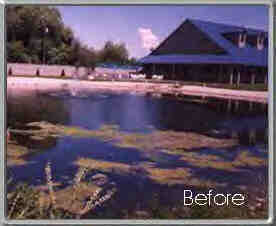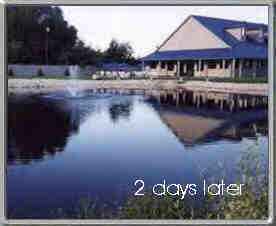

Use of Aquatic Herbicides at Timber Lakes:
Are they safe?
By David Cooper
Instructor Demetria Shew
Natural History of the Pacific Northwest
7 June 2000


The Issue
On June 1, 1999, all the residents of Timber Lakes received notices that an effort was under way to control or eliminate certain aquatic plants in our lakes. The notice informed us that the selective herbicides Aquathol�, Copper compounds, and Rodeo� would be used. Personally, I was concerned about toxicity and potential contaminations to our well waters. I decided to research the issue and the chemicals involved before I made any snap decisions.
Why use a Selective Herbicide?
When a chemical is designed to target a certain plant or species of plant, this is a selective herbicide. Many water management groups deal with unwanted plants such as excessive algae and tall or thick weeds by using these chemicals. Why are these plants unwelcome? Often, fertilizer runoff from local lawns or farms over-feeds lakes and ponds creates eutrophication. This accelerating of plant growth causes a massive algae bloom or weed growth. It is nature's way of regulating water quality. Eventually, the plants would have absorbed all the nutrients, slowing down plant growth and reaching a balance. But when unchecked, the constant and unending flow of nutrients and subsequent algae bloom will eventually kill off fish when all the oxygen is depleted. Another headache is the invasive plants, such as the Eurasian milfoil. This underwater plant grows tall, forming a canopy that puts native plants in total darkness, killing them.
These herbicides kill plants without removing them from the water. This places an abundance of decaying plant material in the sediment and provides a rich base for new plants to sprout up. So knowing this, herbicides should be viewed as a temporary fix to an underlying problem.
Aquathol�
This substance is a chemical whose primary ingredient is Endothall (disodium endothall). It is a member of the dicarboxylic acid chemical class.(1) Specifically, it is concentrated and the potassium and amine salts are extracted and used to kill certain plants on contact. That means they kill plant tissue very quickly. For example, Reward (similar to Aquathol�) destroys the outer cell membranes, actually of both plants and animals. Looking at the data, one would assume they are very toxic since it takes only a teaspoonful to cause human toxicity. But, Aquathol� is very susceptible to microbial degradation. In fact Aquathol� is degraded to the innocuous compounds carbon dioxide and water within 10 - 14 days. But, The EPA uses an alphabetical system of A to E in how they categorize the cancer potential of a pesticide. "A" compounds have been shown through tests to cause human cancer. "E" compounds have been shown through tests to be non-carcinogenic. Aquatic herbicides are either category D, in which the evidence to date suggests that it is non-carcinogenic, or E in the case of Aquathol�, Reward�, Sonar�, and Rodeo�, in which case animal tests have shown that these compounds are non-carcinogenic.(2)
Copper sulfates
Certain copper compounds have the ability to dissolve cellulose or plant matter. It is considered harmless to humans in small quantities because it is insoluble in fats. For example, the infamous DDT was soluble and would remain forever in animal tissues. Will copper sulfate cause cancer? The answer is no and the reason is this: Humans require trace amounts of copper in their diets for normal health. A vitamin pill with mineral supplements contains 2 mg of copper. Now, if you were to treat a body of water at the standard use rate for copper sulfate or any of the copper related products, you would have to drink 8 liters, or more than 2 gallons, of treated water to get the amount of copper that is present in just one vitamin pill. And remember, even if you could drink 2 gallons of water every day, copper is gone from the water in 7 days. Consequently, there is no long-term exposure to the copper compounds. When we swim in herbicide-treated water, we take these compounds in through our mouth. They stay in the water part of our body and exit through the urine. They do not build up in our fatty tissues and consequently do not cause major problems in terms of birth defects and other sorts of health hazards. The vast amount of literature and scientific studies on the use of copper as a mineral nutrient indicates no evidence of a potential to cause cancer.(3)
Rodeo�
This chemical acts very differently than the previous two. Its primary
ingredient is glyphosphate. An excess of glyphosphate kills susceptible
beneficial insects that prey on insect pests (dragonfly and their larvae), and
it is extremely toxic to fish and shellfishes. Repeated herbicide use over a
long period of time also encourages development of herbicide-resistant
weeds.(4) The herbicide Rodeo� inhibits the synthesis of a plant's certain
amino acids, tryptophan, phenylalanine, and tyrosine and it does this by very
specifically inhibiting the enzyme EPSP synthase that catalyzes the reaction
that leads to the formation of these three amino acids. Animals do not make
EPSP synthase, only plants. It means that it cannot make proteins and
without proteins a plant cannot grow and will eventually die. Consequently,
Rodeo� affects plants and not animals. Does it degrade? Yes, because the
Rodeo molecule has a negative charge. That negative charge is going to be
attracted to the positive charges that are surrounding the clay particle.
Consequently, the Rodeo� molecule is going to be very tightly bound to the
clay particle. Once the Rodeo� molecule is attached to the positive charges
associated with the clay particles, it is effectively bound and can no longer
affect plants. It also becomes very susceptible to decomposition by the
microbes that are in the water. In fact, Rodeo� is a very simple molecule
and consequently the microbes have a very easy time of breaking it down
to obtain the carbon, nitrogen, and hydrogen that they need for their own
metabolism. This is one of the reasons why Rodeo� has a very short
persistence time in water and in the environment generally.(5)
Are they Safe?
All pesticides must undergo a thorough screening and analysis before the EPA or the Environmental Protection Agency can register them for use. Each pesticide undergoes up to 140 different kinds of tests and analyses. These tests include acute toxicity (how much of the compound causes immediate death to the test animal) and chronic toxicity (how much of the compound causes death over a longer period of time). Pesticides are tested for their carcinogenicity (their ability to cause cancer) and for their mutagenicity (their ability to cause genetic defects). They are also screened for their persistence in the environment, and many other kinds of tests are conducted.(6) My personal belief is that, yes they are safe, "as far as we know." Some of these chemicals have only been manufactured for a decade or so, resulting in little research. I fear for eventually finding out 'lo and behold' there are side effects from long-term exposures.
Other Options to Herbicides
Lake and pond management is a complicated juggling act. The source of problems must be addressed rather than short-term solutions. An example is, finding sources of excessive fertilizer runoff. Then treat that problem or look for alternatives to even using them in the first place. Weed kills often feed the next generation of algae and plants. Mechanical and physically removing plants is arduous but very successful in some areas. Humans tend to look for the quick fix, though it may only be temporary. One must first understand nature's cycles and learn to work with these cycles, instead of against them.
Works Cited
1 Pictures from web site. Environmental Solutions, 3 June 2000
<http://www.environmentalsolutions.net/respond1.htm>
2 From web source. Extoxnet -Extension Toxicology Network, 3 June
2000 <http://pmep.cce.cornell.edu/profiles/extoxnet/dienochlor-
glyphosate/endothall-ext.html>
3 Lembi, Dr. Carole. Why Aquatic Herbicides Affect Aquatic Plants
and Not You! 3 June 2000
< http://www.btny.purdue.edu/aquatic/transcript.html>
4 "Weed Control," Microsoft® Encarta® Encyclopedia 2000. ©
1993-1999 Microsoft Corporation. All rights reserved.
1. 1 From web source 2 Web source 3 Web source 4 Encyclopedia source 3 Web source 3 Web source